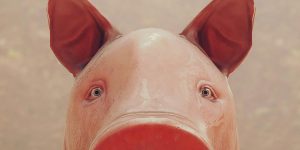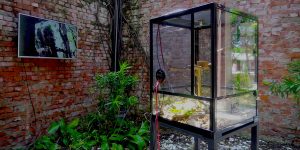habitat

Pig Simulator
Stephan Isermann (DE)
The Pig Simulator takes place in virtual reality but also in real space. The goal is to escape the slaughter in virtual reality – and, as in the real life of the real pig, this idea becomes futile. The user will live and die like a pig and experience the habitat of the animal as closely as possible through the virtual embodiment of an artificial and cruel habitat designed by humans to satisfy our desire for mass consumption of meat. The Pig Simulator may subvert common expectations about gaming and fights the dark irony of a just world of unequal life forms living in the shared habitat called Earth.

close encounter
Jan Georg Glöckner (DE)
Living sculpture (2019) The work displays a fungus living in a 90 liter bioreactor. In the bioreactor the fungus is kept alive by an artificial life support system that supplies it with the water, sugar, and oxygen that are its basic needs. The fungus adapts to this system and transforms its body into round pellets that are submerged into the liquid. The bodily presence of the fungus in the bioreactor offers humans the chance to observe and to reflect about so-called “natural” and artificial habitats.

Humus, Humanity & Humility
Julian Chollet (DE)
Humus is more important than art, money, or success. Humanity depends on intact ecosystems and fertile soil. Humility and responsibility will help our species survive.

Shared Habitats
The exhibition Shared Habitats focuses on the influence of technology on socio-cultural processes through fourteen works of a digital, biological, and interactive nature. The exhibition focuses on the location of organisms in their environment, the effects of humans on their habitats, and the artistic handling of new biomaterials and technologies. Many of the works on display are based on scientific experiments that are analyzed in a cultural context.

Species Reclamation Via a Non-linear Genetic Timeline: An Attempted Hymenochirus curtipes Model Induced by Controlled Breeding
Brandon Ballengèe (US)
This project involved the selective breeding of frogs from the Hymenochirus family, located in the Congo. There, biodiversity is threatened by forest clearing and increased demand for wood. Also, political turmoil in Congo has limited biological studies and conservation efforts. In their native habitat, wild Hymenochirus populations may currently be in decline or have become extinct.


